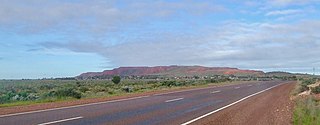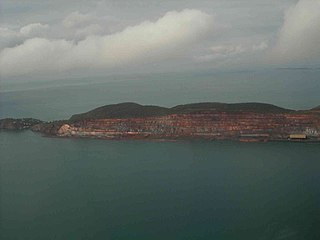
Iron ores are rocks and minerals from which metallic iron can be economically extracted. The ores are usually rich in iron oxides and vary in color from dark grey, bright yellow, or deep purple to rusty red. The iron is usually found in the form of magnetite (Fe
3O
4, 72.4% Fe), hematite (Fe
2O
3, 69.9% Fe), goethite (FeO(OH), 62.9% Fe), limonite (FeO(OH)·n(H2O), 55% Fe) or siderite (FeCO3, 48.2% Fe).

The Mesabi Iron Range is a mining district in northeastern Minnesota following an elongate trend containing large deposits of iron ore. It is the largest of four major iron ranges in the region collectively known as the Iron Range of Minnesota. First described in 1866, it is the chief iron ore mining district in the United States. The district is located largely in Itasca and Saint Louis counties. It has been extensively worked since 1892, and has seen a transition from high-grade direct shipping ores through gravity concentrates to the current industry exclusively producing iron ore (taconite) pellets. Production has been dominantly controlled by vertically integrated steelmakers since 1901, and therefore is dictated largely by US ironmaking capacity and demand.

Whyalla was founded as "Hummocks Hill", and was known by that name until 1916. It is the fourth most populous city in the Australian state of South Australia after Adelaide, Mount Gambier and Gawler and along with Port Pirie and Port Augusta is one of the three towns to make up the Iron Triangle. As of June 2018, Whyalla had an urban population of 21,742, having declined at an average annual rate of -0.75% year-over-year over the preceding five years. It is a seaport located on the east coast of the Eyre Peninsula and is known as the "Steel City" due to its integrated steelworks and shipbuilding heritage. The port of Whyalla has been exporting iron ore since 1903.

The Eyre Peninsula is a triangular peninsula in South Australia. It is bounded by the Spencer Gulf on the east, the Great Australian Bight on the west, and the Gawler Ranges to the north.

Iron Knob is a town in the Australian state of South Australia on the Eyre Peninsula immediately south of the Eyre Highway. At the 2006 census, Iron Knob and the surrounding area had a population of 199. The town obtained its name from its proximity to large deposits of iron ore, most notably Iron Monarch which outcropped prominently from the relatively flat, surrounding landscape.

Cockatoo Island is an island in the Buccaneer Archipelago off the coast of Western Australia near the town of Derby. It was mined for iron ore by the Broken Hill Proprietary Company from 1951 until 1984. Koolan Island is a neighbouring island that was also mined by BHP for high grade iron ore. It was most recently mined by Perth-based mining company, Pluton Resources until the company was placed under administration in September 2015.
Arrium was an Australian mining and materials company, employing nearly 10,000 workers, that went into voluntary administration in 2016 with debts of more than $2 billion. In 2017 it was acquired by British-owned Liberty House Group.

Port Bonython is the location of a deepwater port, gas fractionation plant and diesel storage facility west of Point Lowly in the Upper Spencer Gulf region of South Australia. It lies 16 km east-northeast of Whyalla, South Australia and approximately 370 km north-west of the State's capital city, Adelaide. The existing wharf is 2.4 kilometres long and is capable of berthing small Capesize ships with a maximum capacity of 110,000 tonnes. The wharf was established in 1982 and named after John Bonython, the founding chairman of Santos. The structure is leased to Santos by the Government of South Australia and is used for the export of hydrocarbon products. An oil spill at Port Bonython in 1992 resulted in loss of bird life and damage to mangrove habitats to the west and southwest of Port Pirie.
Iron Baron was a settlement associated with the Iron Baron iron ore mine on Eyre Peninsula at the southern edge of South Australia's Far North region, 413 kilometres north-west of Adelaide.

The Whyalla Steelworks is a fully integrated steelworks and the only manufacturer of rail in Australia. Iron ore is mined in the Middleback Range to feed the steelworks, resulting in the distribution of finished steel products of over 90 different grades. It occupies a 1,000 ha site on the shore of False Bay, Spencer Gulf and is the largest employer in Whyalla, South Australia.
The Wilcherry Hill Project was originally a proposed iron ore mine and associated infrastructure on Eyre Peninsula, South Australia. It was proposed by Ironclad Mining Ltd which later merged with Trafford Resources to become Tyranna Resources. As of 2018, the Wilcherry Project is a joint venture between Alliance Resources (67.35%) and Tyranna Resources (32.65%). The venture is exploring for economic concentrations of any of gold, tin, copper, zinc, lead, silver, iron, bismuth, tungsten and uranium.
The BHP Whyalla DE class are a class of diesel locomotives built by Clyde Engineering, Granville for BHP between 1956 and 1965.
The Whyalla News is a newspaper serving the town of Whyalla on Eyre Peninsula, South Australia since 1940. It was later sold to Rural Press, previously owned by Fairfax Media, but now an Australian media company trading as Australian Community Media.
Waterhouseite, Mn7(PO4)2(OH)8, is a hydroxy manganese phosphate mineral. It is a medium-soft, brittle mineral occurring in pseudo-orthorhombic monoclinic bladed crystals and orange-brown to dark brown in color. Waterhouseite is on the softer side with a Mohs hardness of 4, has a specific gravity of 3.5 and a yellowish-brown streak. It is named after Frederick George Waterhouse, first director of the South Australian Museum, as well as recognizes the work Waterhouse Club has done in support of the South Australian Museum.
Middleback Range is a locality in the Australian state of South Australia located in the north east corner of Eyre Peninsula to the south-west of the city of Whyalla and extending from the coastline of Spencer Gulf in the east to the west side of the southern end of the Middleback Range in the west.

The County of York is one of the 49 cadastral counties of South Australia. It was proclaimed by acting Governor Samuel Way in 1895 and named for King George V who was known at the time as the Duke of York. It covers a portion of the state on the Eyre Peninsula east coast at the latitude of Whyalla. It stretches westwards to the eastern boundary of Lake Gilles Conservation Park
SIMEC Group Ltd is a British international energy and natural resources business focused on resources, sustainable power, infrastructure, and commodities trading. In 2016 it had an annual turnover of almost USD2.5 billion and net assets of USD350 million. It is part of the Gupta Family Group ("GFG") Alliance, owned by members of the Gupta family, which had a combined turnover of more than USD13 billion and combined net assets of more than USD2.3 billion. Its activities span renewable energy generation, mining, shipping, and commodities trading.
The BHP Whyalla Tramway is a 1067 mm gauge heavy-haul railway, 112 kilometres long, on the Eyre Peninsula in South Australia. It runs from haematite mines at Iron Monarch, Iron Baron and Iron Duke in the Middleback Range, about 50 kilometres west of Whyalla, to company steelworks at the coastal city of Whyalla. Opened in 1901, it was built by, and until 2000 operated by, the Broken Hill Proprietary Company (BHP). As of 2021 it was owned by Liberty House Group and operated on its behalf by rail operator One Rail Australia, which was sold in 2022 to Aurizon.
The South Australian Iron and Steel Company, officially South Australian Iron and Steel Company Limited, was a colonial era iron-making venture, located in the Hindmarsh Tiers, near Mount Jagged, in the upper reaches of the Hindmarsh River valley, South Australia. Its blast furnace operated intermittently, over the period from 16 July to 5 December 1874.









